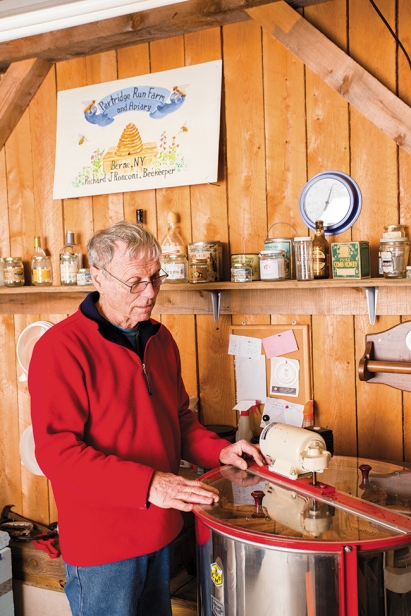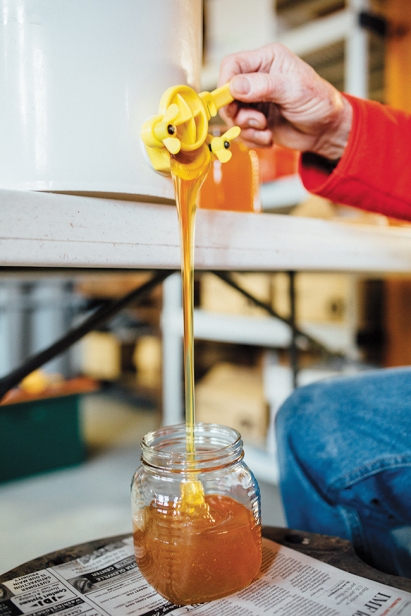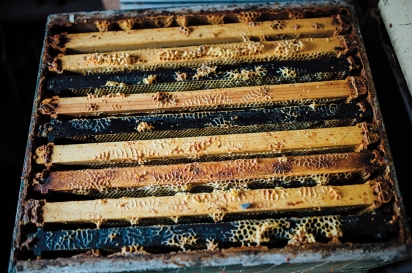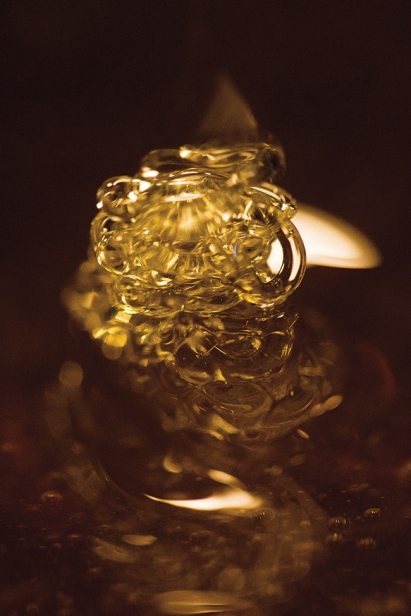The King of Queens
A honeybee is intrinsically free-range.
Perhaps because of that, the substance it creates, comprised of the plant and tree nectar it gathers during its perambulating travels, has become a kind of allegory for what’s happening to agriculture. Honey, simple as it seems, depends on a complex web of relationships between insects, plants and animals, and seems to harbor the answers to many riddles we haven’t even learned how to ask yet.
The birds and bees have provided an easy primer for life, sex and the workings of the natural world since time immemorial, but it hasn’t been until recently that the full impact of human activity has been so starkly visible in their most visible product.
“I could talk about honey and bees all day,” Richard Ronconi, the owner and operator of Partridge Run Farm & Apiary says. “The issues large-scale commercial honey-makers have had in recent years reflect a lot of what is happening in farming in general. Up here in Berne, I haven’t had the same issues, but that’s because we’re so far from commercial operations.”
Colony collapse disorder has reduced honeybee colonies 30% to 45% in recent years. It has been linked to several dozen environmental causes, most prominently pesticide usage, loss of habitat and climate change. In fact, the disorder has generated a muscular response to unsustainable agricultural practices and lifestyle habits.
It isn’t just the abhorrent notion of a world deprived of buzzing bees and their honey that has galvanized the public. In America alone, honeybees are responsible for pollinating $15 billion worth of agriculture. In addition to the hardship that consistently reduced bee populations would inflict on anyone who eats, there are increasing concerns about the long-range impact nonorganic farming practices are having on the earth and human health. The idea of consuming a product that bears traces of the farming and gardening methods of everyone within a few miles of a bee’s home makes the simple task of spreading honey on morning toast a strangely complex conundrum. While it’s possible to rinse some of the sprays off conventionally grown produce, honey inherently contains traces of those sprays.
Most supermarket honey is as runny as water, because it’s heated up and pasteurized, which zaps out all of the medicinal, anti-fungal, antibiotic properties. Mass-market honey is also often sourced from several different far-flung locations, which some say may minimize its allergy-busting and medicinal powers.
For “real” honey in all of its complexity, and with fewer potential toxins, more people are turning back to their farmers’ market. Richard and Partridge Run Farm & Apiary have become the Capital District’s underground King of Bees, producing unpasteurized, unprocessed seasonal honeys that capture the elusive flavor of flowers. He runs out every year. Richard has also been crowned by insiders, named president of the Catskills Mountain Beekeepers Club. “Real” honey doesn’t necessarily mean “organic,” though.
“It’s almost impossible to produce organic honey,” Richard says. “You can’t control a bee’s flight. They go where they want to go.”
Most bees will stay within a two-mile radius of their hive, he says. Some Western and Southern honey producers create vast tracts of orange groves that are cultivated organically and then park their hives on that land. Technically, the honey is organic. However, the highly controlled setting is artificially manufactured, which seems like the opposite of what honey should be.
Wild, unpredictable, just this side of fierce, yet innocent and achingly sweet. Like Justin before the whole Bieber fever thing happened.
Magic Bees
The science of bees is equal parts fascinating and daunting, and even a superficial scan of beekeeping lit makes us wish we’d paid more attention in AP Bio. Here’s a bee-life primer:
Each hive has one queen. When hives become overcrowded, or the queen becomes older and begins to run out of sperm, the colony of bees understands and responds by feeding the fertilized eggs extra royal jelly, which is extremely high in protein. (Future worker bees are initially fed royal jelly, and then switched over to honey and pollen). Once the new queen hatches and mates, the colony will split into two through a swarm.
Queen bees typically mate with about 15 drones on more than one so-called mating flight. Once the mating is completed, queens return to the hive and lay 1,000 to 2,000 eggs a day during the summer. That one mating flight will supply her with enough sperm to last the rest of her life.
When a queen lays an egg, she determines whether the colony needs a worker or drone and then fertilizes the egg accordingly.
Drones are male bees and are produced from unfertilized eggs, which means they only have the DNA of the queen bee.
Workers and queen bees are both female and result from fertilized eggs, so they have the DNA of the queen bee and a male drone.
Eggs are laid one by one in a cell of honeycomb, which is produced from the body of a worker bee. The youngest worker bees are responsible for cleaning the hive and feeding larvae.
Worker bees cooperate through a waggle or bee dance to communicate the presence of food sources to each other.
In the winter in cold climates, honeybees stop flying when the temperature dips below 10 degrees. They crowd around the queen bee and form a cluster, shivering and batting their wings to keep warm. The workers rotate in and out through the cluster, trading warm and cold spots. They consume honey to produce body heat.
In addition to producing honey, bees produce beeswax from glands in their abdomen. The wax is used to form the walls and the caps of the comb. Bees collect pollen, carry it back to the hive and use it as a protein source to raise their brood. Many beekeepers collect pollen as it is frequently consumed as a health supplement. Bees also produce propolis, created from resins and tree saps. Propolis is also consumed as a health supplement and is used in some lotions and cosmetics.
Partridge Run Farm Honey is available at Honest Weight Co-op, Fin the Fishmonger, Short & Stout Tea Co., La Perche and other markets, plus farmers’ markets in Rensselaerville and Voorheesville and fairs. Partridge Run Farm & Apiary is located at 484 Ravine Road, Berne, NY; 518-797-3922.










